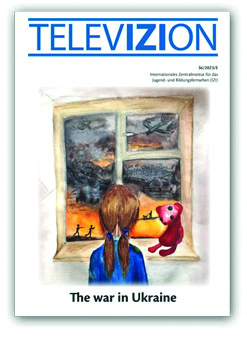|
 >> Overview publications
>> Overview publications
EDITORIAL
February 24, 2022 – Oleg’s mother woke him before sunrise. 10 minutes later, they were sitting in the car and travelling through the night. A rocket flew through the sky, and when it exploded, everything was instantly illuminated. “Wow! That’s beautiful”, Oleg said, and then his parents explained to him what these rockets meant.
When Ukrainian children and adolescents talk about their experiences during the war, they describe, among other things, the feeling of an all-encompassing threat without any sense of safety, the destruction of civil livelihood, helplessness and hopelessness. When Ukrainian children and adolescents who have lived as internally displaced persons since the start of the Russian war of expansion in 2014 film their emotional world, they convey the turmoil and psychological impact of life under constant bombardment (Schüpp). These are experiences which, accor ding to current research, will mark them for a lifetime and are likely to stunt their development (vom Orde). At the same time, Ukrainian adolescents have certainly proved their competence in using media to communicate, find information, and regulate their own emotions (Lopatovska). What becomes clear is that despite their suffering, children from Ukraine are also full of hope and have unwavering faith that the Ukrainian army will push back and defeat the Russian soldiers, and therefore enable the return and reunification of families (Götz, Pohling & Pütz).
Unsurprisingly, Russian children’s impressions of the current situation in Ukraine are very different, for their information comes almost exclu sively from the Russian state media. From a very young age, they are shaped by a culture of militarism and propaganda (Nouri). The extent to which Russian propagandistic narratives now pervade their inner thinking leaves little prospect of any mutual understanding (Götz).
The war of aggression against Ukraine is already regarded as a water shed moment, one that can already be described as historic in various spheres – from security and energy policy through to the current infla tion. The conflict in Ukraine is also one of the first major crises in which social networks such as TikTok (Bösch) and Twitter (Msughter) have played a leading role in the dissemination of information and disinfor mation. Although the mainstream news programmes have not relayed any “fake news”, a few broadcasters have indeed presented reports that have been, at times, significantly more dramatic and emotional than others (Holler & Fößel). It is precisely this additional emotionalisation and images of suffering children, dead and injured people that children prefer to avoid in coverage aimed at their age group (Mlapa). It is therefore all the more important that children’s media worldwide take a careful approach to the subject (Dreesen et al.).
Maya Götz
Head of the International Central Institute for Youth and Educational Television
RESEARCH
Marcus Bösch
WARTOK – TikTok and the war
in Ukraine
The author shows how, in 2022, the video platform TikTok became a focal point for images and interpretations from the warzone. As well as multiperspectival documentation and eye witness accounts, however, there is also disinformation and propaganda, and this challenges the media competence of young users.
Aondover Eric Msughter
Internet memes as a tool for the propagation of fake news on Twitter
Andrea Holler/Miriam Fößel
What television news reports
An IZI study analysed coverage in German
television's primary news programmes
for adults and children on the war in
Ukraine, looking into the various themes
portrayed.
Maya Götz/Lara-Sophie Pohling/ Anne Pütz
"Get up! There's no school today, there's a war on"
In a qualitative study, 21 Ukrainian children (who had come to Germany as refugees) were asked about their experiences of the beginning of the war and their perceptions of the current situation. The article summarizes the role of the media and what children would like to see on television in this context.
Irene Lopatovska
"No game or movie prepares you for this feeling. I was really scared."
Maya Götz
"The whole world is lying about Russia!"
How Russian children see the war in Ukraine.
Manda Mlapa
"Bombs are falling from the sky and everything is being destroyed"
How German children imagine the situation in Ukraine and what they want to see in a children‘s programme on this topic.
Maya Götz/Andrea Holler
Adolescents' knowledge at the start of the war in Ukraine
A qualitative study with 59 7- to 15-yearolds living in the municipalities of Chiapas in Mexico inquired how inclusion, participation and empowerment is perceived in the representation of children in the children's news programme ¡Vientos!, noticias que vuelan.
POINT OF VIEW
Ekaterina Nouri
Russian children's everyday life in 2022
RESEARCH DOCUMENTATION
Heike vom Orde
Children and adolescents in the stresses of war
PROGRAMME
Anne Dreesen/Josephine Hattevig/Eirin Nilssen Vikøren/Geir Evensen/Tina Antoncic/Lisa Fender/Marie McCann/Elke Franke/Marcela Benavides/Sandra Téllez/Yasuda Shin
How was the Ukraine war addressed in children's programming around the world?
TV executives and programme makers worldwide were asked how they had reacted to the Russian attack on Ukraine and if they had produced special programmes for children dealing with the topic. Furthermore, we wanted to know which feedback they had received on the contributions and which lessons they have learned from this for the future.
MEDIA EDUCATION
Chris Schüpp
»OneMinutesJr«:
Ukrainian adolescents share their
experiences of war
|




